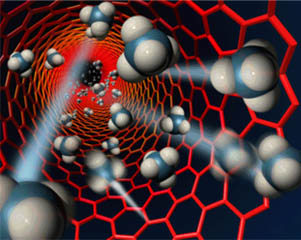 The technology of nanotubes is becoming quite crucial these days as it has multiple uses in various fields.
The technology of nanotubes is becoming quite crucial these days as it has multiple uses in various fields.Researchers at MIT have found that carbon nanotubes can serve as highly sensitive biological sensors for detecting single molecules in living cells in real time. The study, published online in Nature Nanotechnology is the first demonstration that nanoscale sensors can be used to detect and image multiple types of molecules in cells at the same time, at a sensitivity that far exceeds that of fluorescent dyes, the standard tool for molecular imaging. The researchers used the sensors to detect substances that damage DNA, including certain cancer drugs and toxins. The sensors could eventually be used to monitor the effectiveness of chemotherapy drugs, track molecular interactions in cells, and test for low levels of toxins in the environment.
That's not all! In fact they can even identify chemotherapy drugs, which are very powerful DNA disruptors and further, these sensors also have the ability of identifying toxins and other free radicals that pose a threat to DNA. The good thing is that these sensors can be placed into living cells without much trouble and then several of the agents that can affect DNA could be detected via it.
Furthermore, these sensors can also lend a helping hand as the chemotherapy analyzer that could make it lot easier to determine if the very powerful chemotherapy drugs used to destroy carcinogenic cells are really doing their job or not.
Apart from this, the scientist are also planning to utilize the sensors with the aim to study the effects of various anti-oxidants on DNA and also to learn as to how to make chemotherapy treatment far more effective than it is at present.
When asked as to how these sensors work, the scientists replied, "Apparently, each of the nanotubes is coated with DNA, which enables them to bind to DNA damaging agents present in the cell (if any). Now, carbon nanotubes have this ability to emit florescent light when subjected to infrared radiation/light. If there is an interaction between the DNA coated on the carbon nanotube and DNA damaging agents, the wavelength of the fluorescent light emitted by the DNA coated carbon nanotube changes. Depending on the wavelength change, scientists would be able to determine the specific agent that caused the change - accurately identifying it in the process."
The concluded, "The nanotubes coated with DNA can be safely injected in to the body, which makes their use a very easy affair. Continuous research in this field will ensure that in future, cancer treatments would be not only faster, but will also turn out to be much more efficient."
window.google_render_ad();

No comments:
Post a Comment